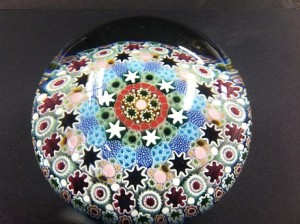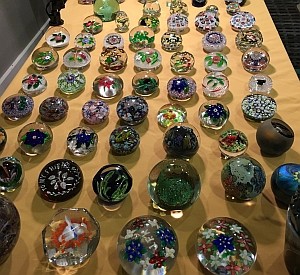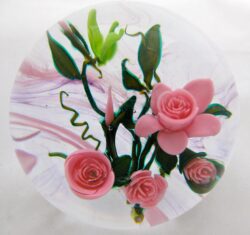William Pitt, like many graduating seniors, figured on a lifetime of work with Ford Motor Company. His degree in Mechanical Engineering from Lawrence Technological University helped him move from the automotive industry to the aerospace industry in California. When aerospace nosedived in the late 1980s, he moved to Massachusetts, thinking of another technical job. Didn’t happen. He needed a different career.
An Alternative to Mechanical Engineering
A friend of his who owned an antique store offered Will a temporary job while he looked for work. Will’s background in corporate settings helped grow his friend’s business. He encouraged his friend to attend shows, improve his advertising and use auctions as an outlet; the business thrived. When his business partner encouraged him to dive into a specialty, he chose paperweights.
“I always liked selling the glass, more than other items. Paperweights became a logical choice as I loved the technology behind the product as much as the beauty of the artistry.” He talked with the artists, read and studied many books about the history and technical aspects of the craft. He was hooked. He started his own business in 1994.
His self-employment created the opportunity to travel worldwide. When he visited Europe, he found his path into the countryside, forming relationships with artists and buyers. In 1996 he developed his website, which shows the artistry of old masters of paperweight, such as Clichy and St. Louis, while introducing the public to emerging artists from the U.S. and other destinations. World renowned artists like Rick Ayotte, Ken Rosenfeld and Debbie Tarsitano are his friends and business associates. They are the artists. He sells their paperweights.
Attracting New Paperweight Collectors
Will and I talked about the dwindling numbers of paperweight collectors. We can find inexpensive paperweights, even at Walmart, but the antique paperweights can fetch as much or more than $50,000. The manufactured weights (made in quantities) bring far less.
Well known paperweight artists can command anywhere from $200 to thousands of dollars. Some make glass jewelry and other art glass. Paperweight artists break many more pieces than finished products. The “lampwork” entails tiny pieces of glass, which the artist encases in the clear glass, usually using the familiar round shape. Paperweight making requires hours and hours of tedious work. Buying a paperweight is like buying an oil painting from an emerging or famous painter. The weight anyone purchases from a well-known artist will undoubtedly appreciate. A novice paperweight collector needs to study and read glass history and comprehend the value. Beginners benefit from attending paperweight collector meetings and watching for bargains, even when out for a Sunday drive stopping by flea markets or antique stores.
At the Paperweight Collectors Association of Texas’ recent meeting, the group assembled Friday evening for dinner and enjoyed the meeting on Saturday in Fort Worth. Damon MacNaught spoke about his recent training at the Corning Museum of Glass. Mr. Pitt, the featured dealer, brought an outstanding array of paperweights for members to purchase.
My addiction started with curiosity about a weight I inherited. I’ve developed the same passion for paperweights as Will Pitt, but I don’t sell them. If you like glass (especially paperweights), attend the next meeting, in Galveston, Texas on 2/27/2016. See the event tab for additional details.
By Ruth Glover






